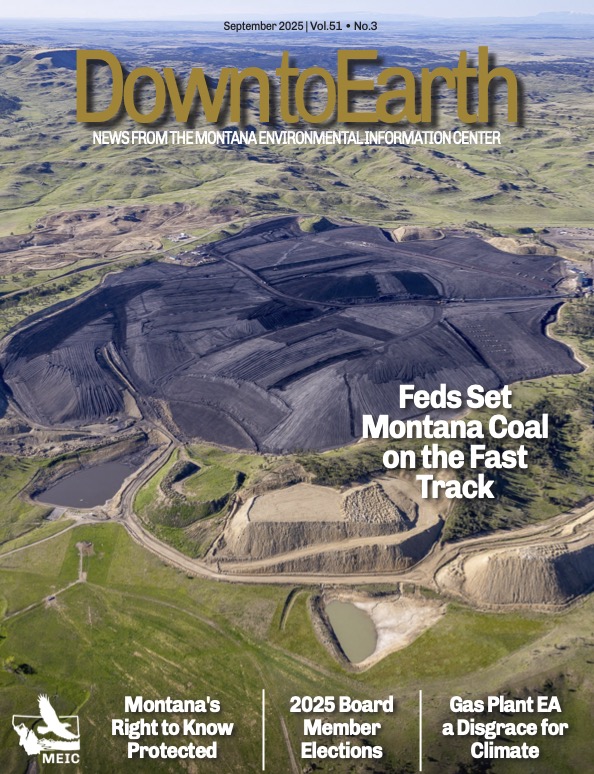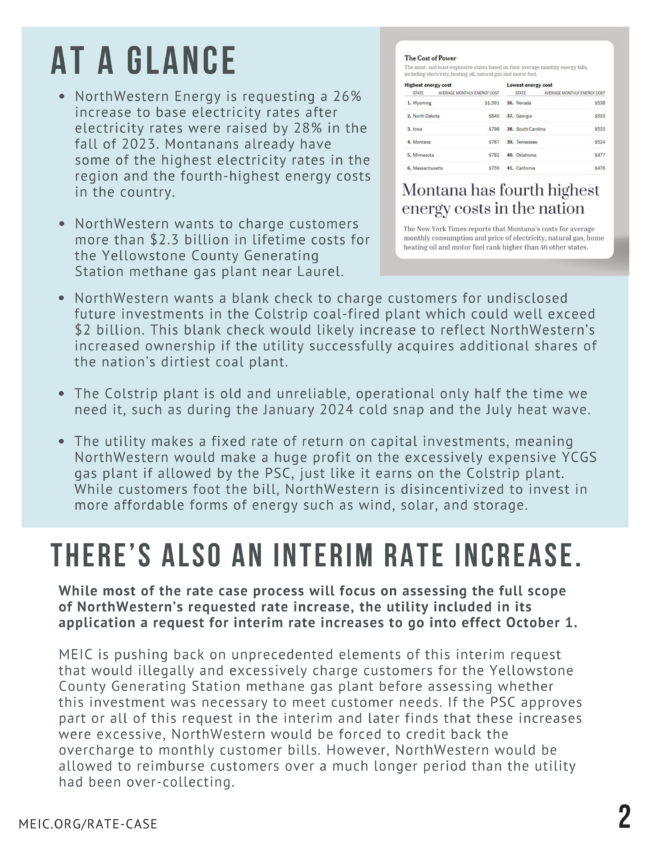




Montana environmental news.
We protect and improve Montana for future generations.

Protecting Air & Water
Protecting and advancing air and water quality standards to ensure a clean and healthy climate for future generations. Campaign areas include fighting hardrock mines and pushing for air pollution regulations at power plants and industrial pollution sources.

Climate & Energy
Reducing our dependence on fossil fuels through an equitable transition to renewable and clean energy sources. Campaign areas include NorthWestern Energy accountability, development of clean and affordable energy, promotion of energy efficiency, and fighting coal, oil, and gas development and use in Montana.
Down to Earth
Stay up-to-date on the latest environment news in Montana with Down to Earth, our quarterly membership publication.
A Victory for Montana’s Sunshine Laws
MEIC exists on the edge of government and its operations. If you boil down our day-to-day work, a substantial portion is the pick-and-shovel work of document review in order to hold the government accountable.
Bull Mountain Coal Mine Gets Sweetheart Deal from Feds
Pres. Trump’s Executive Orders were issued fast and furious in his first months in office, a slew of legislation has been introduced in Congress to roll-back basic environmental standards, and the U.S. Environmental Protection Agency is priding itself on instituting the largest “regulatory rollback” in history.
DEQ Thumbs Nose at Montana Constitution, Approves Gas Plant
The Montana Department of Environmental Quality (DEQ) thumbed its nose at the Montana Supreme Court, the people of Montana, future generations, and our Constitutional Right to a Clean and Healthful Environment when it released its draft and final environmental analyses for NorthWestern Energy’s gas plant near Laurel.
New Data Centers Threaten to Increase Montanans’ Electricity Costs
Data center investors are making plans to come to Montana soon. As in “as soon as possible.” While NorthWestern Energy doesn’t have a clear plan for supplying the vast amount of power it will need, it’s becoming clear who it expects to pay for the generation and grid infrastructure to serve these huge customers. The question is, should Montanans be required to subsidize behemoth tech companies?
The Latest Stories and Actions from MEIC
Recording: Promising Horizons for Enhanced Geothermal Energy
November 19, 2025Recording – The Inside Scoop Webinar: Fighting Back at the Federal Level
November 14, 2025
Let's rise up.

Help protect Montana’s clean air and water.
For 50 years, MEIC has worked to keep Montana’s air and water clean. We have stopped dirty acid mines and helped pass and defend strong pollution control laws. And it’s all made possible by our members.
MEIC is made up of thousands of Montanans who care deeply about this state – our home. This strong membership has allowed MEIC to remain independent and to always fight for what is right. We would love to have you as a member too.
MEIC in the News
DEQ taking public comment on proposed guidance for greenhouse gas assessments
Oct. 20, 2025 – The new guidance will be closely watched by groups like the Montana Environmental Information Center. MEIC has sued DEQ, claiming its current greenhouse gas assessments aren’t sufficient to comply with Held.
Not so fast: Groups warn of downsides to potential data centers in Butte
Oct. 17, 2025 – “A lot of people have already heard the data center side — that they’re great for the economy, they’re great for jobs, they’re great for everybody and everything,” Anne Hedges, executive director of the Montana Environmental Information Center, told about 70 people at a forum on the issue in Butte Thursday night. “But a lot of other places in the nation have been experiencing something very different.”
More News:
Save Our Smith—more than just a river.
The Smith River is not a location for another failed mining experiment.
Montana’s Smith River is renowned worldwide for its clean water, rugged canyon scenery, and blue ribbon trout fishery. The Smith is Montana’s only permitted recreational river. The permitted section of the Smith River winds 59 miles through a remote canyon in the Big Belt Mountains. Montana Fish, Wildlife, and Parks classifies the Smith River’s fishery as high-value, owing to its bountiful population of rainbow, brown, westslope cutthroat, and brook trout. The canyon walls of the Smith also boast some of the best examples of Native American pictographs in Montana.
Urge Montana to protect the Smith.
Montana’s Smith River is an extraordinary resource, and deserves our most rigorous effort to protect it from mine pollution and dewatering. Montana Governor Greg Gianforte and the Department of Environmental Quality Director Chris Dorrington will make critical decisions that will determine the future of the Smith River and the Sheep Creek Mine.
Please contact Governor Gianforte and Director Dorrington. Let them know that the Smith River is an incredibly important place for the people of Montana and across the country and world, and should not be sacrificed for temporary and risky mining activities.
It’s time to make a stand.
The Smith River and its tributaries provide crucial habitat and spawning grounds for regional trout fisheries. The Sheep Creek drainage accounts for over half of tributary spawning of rainbow trout in the Smith River drainage, and rainbow trout have been known to travel nearly 200 miles round-trip from the Missouri River to spawn!
The Smith River depends on clean cold water from its tributaries to sustain the aquatic life within its banks and the agricultural operations along it. Demands on the river’s waters already often exceed available flows in many years, creating challenges for downstream water users.

Stay Connected
P: (406) 443-2520
E: meic@meic.org
324 Fuller Ave, #C-8
Helena, MT 59601
Mailing addresses:
P.O. Box 1184, Helena, MT, 59624
225 W. Front, Missoula, MT, 59802





